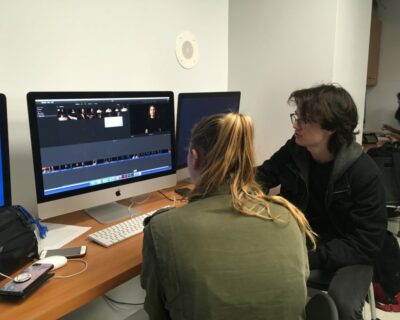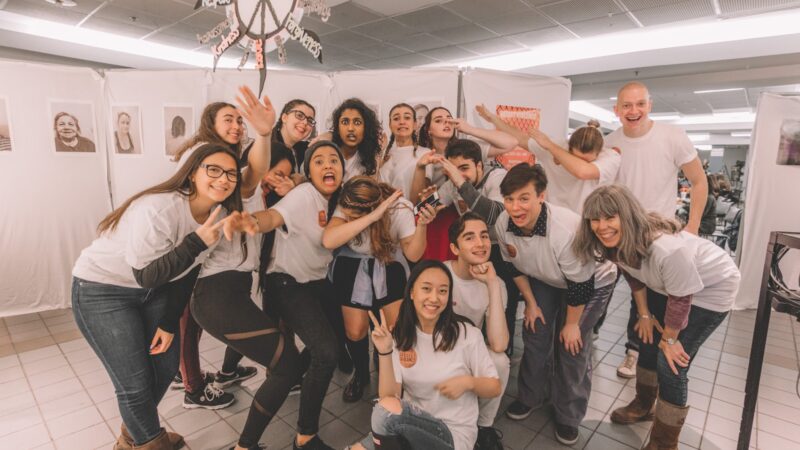Educators from across Canada will learn about the Resist Violence Pedagogy developed at Dawson on April 28 at Changing Narratives, CICan’s national conference.
Pat Romano (Faculty, Humanities), Kim Simard (Faculty, Cinema | Communications) and Anick Legault (Faculty, Psychology) are the presenters along with Dawson graduate Miryam Guirguis (Class of 2020, Health Science).
New pedagogy has a website and a Community of Practice
“The pedagogy is having a wider impact than we had imagined when we began,” Pat said. Pat and Kim taught a Learning Communities paired course entitled Imaging Violence and Nonviolence in the Fall 2016 semester. Over the past five years, they have developed a pedagogy, created a comprehensive website and brought together four teachers in a Community of Practice to share and learn from each other.
This pedagogy provides a way for students and teachers to engage in dialogue on social issues at a time when issues are extremely polarized. “This is a not a calling out pedagogy,” Kim said. “The focus is not only on what is wrong, but on what we can do to create a better world.”
Creating openness before the barriers go up
By emphasizing interconnections between issues and inviting students to express themselves through art, the goal is to create an atmosphere of openness and appreciation before barriers go up. “How do you find ways to gently and provocatively break through the resistance in the classroom?” Pat said. “We know that anger, denial, withdrawal, cynicism and disengagement are present. We have to work to create entry points.”
“Our approach provides multiple entry points,” Kim added. “We are aiming for connection over division.”
This pedagogy integrates critical thinking and creativity, interdisciplinary theory and research with art, storytelling, and activism. “When learning to be critical about issues in the world, many in the class want to express themselves about it in a personal way. Developing creative responses, allows for that. In addition, it encourages connection with others through shared perspectives and experiences.” Kim said.
Beyond a Pedagogy of Discomfort
In their blog post entitled Beyond a Pedagogy of Discomfort, they write, “We use art and storytelling to unexpectedly create spaces where realities that we have not noticed can be acknowledged. Perhaps most importantly, we look for ways to inspire our students to see the value in, and potential for, change – in their own ideas and values, but also in the world they inhabit.
“We draw insights from the theory and practice of nonviolence, integrating into our course concrete examples of how successful movements and activists have worked, often subtly, to draw our attention to the injustices of the status quo and inspire people with visions of a better alternative. Finally, we engage them in using their own creativity to resist the violence that shapes their lives.”
Useful across disciplines
Pat and Kim are enthusiastic about the possibilities for the Resist Violence Pedagogy across many disciplines, especially the Social Sciences.
The Resist Violence approach helps students develop resilience and understand their past experiences. “There is critical hope, even in a complicated and challenging time, to create possibilities for real change,” Pat said.
Student experiences

Kim shared a story from her classroom. A white male student was unsure about expressing his opinion about sexist album covers by some Black rap music artists. “He was actually encouraged to share his feelings about sexism by fellow students who happened to be Black women. They told him, ‘we need people like you to speak up alongside us,’” she recounted.
Feedback from students has been very positive. “They feel empowered to cope with the world; they feel they can do something.” said Pat.
A quote from a student in 2017 is a great testimony to the impact of the approach: “I came into the class angry about things that had happened to me, the way in which I was being treated as a survivor of sexual assault, and this class helped me understand where those reactions came from, and helped me find a way to express that anger in a constructive way.”
Coming soon: a Resist Violence para-academic initiative
Pat and Kim are working on the next stage of this project: creating a college-wide para-academic initiative, entitled Creative Collective for Change. They aim to provide students and faculty with a safe space to engage constructively and creatively on divisive social issues.
NOTE feature For more information, foundational resources, teaching modules, blog entries and videos, check out the Resist Violence Pedagogy website: https://resist-violence.com/



